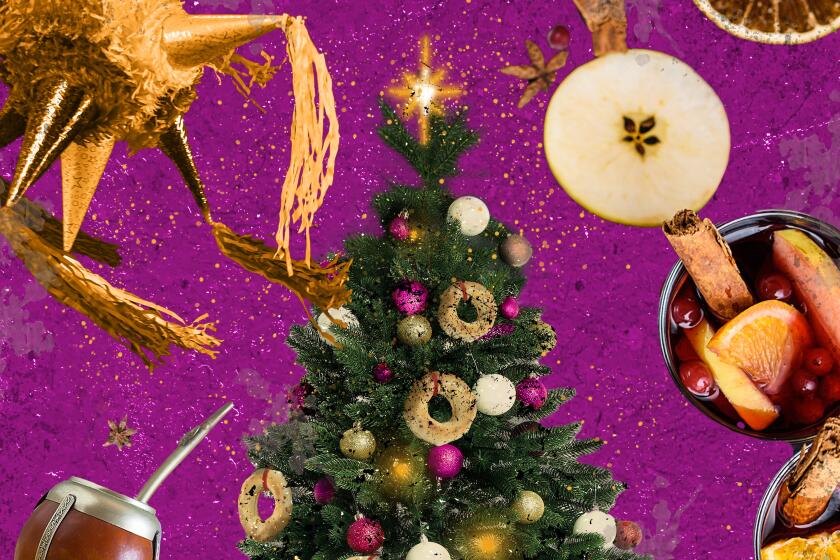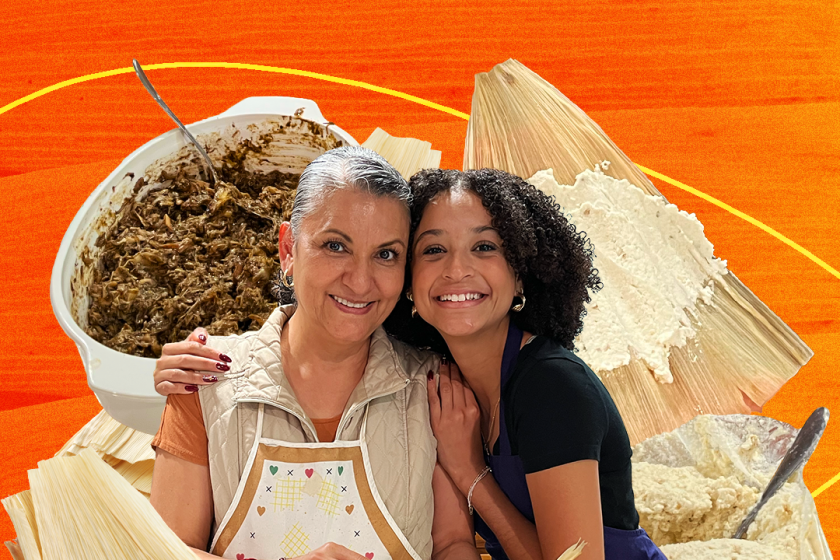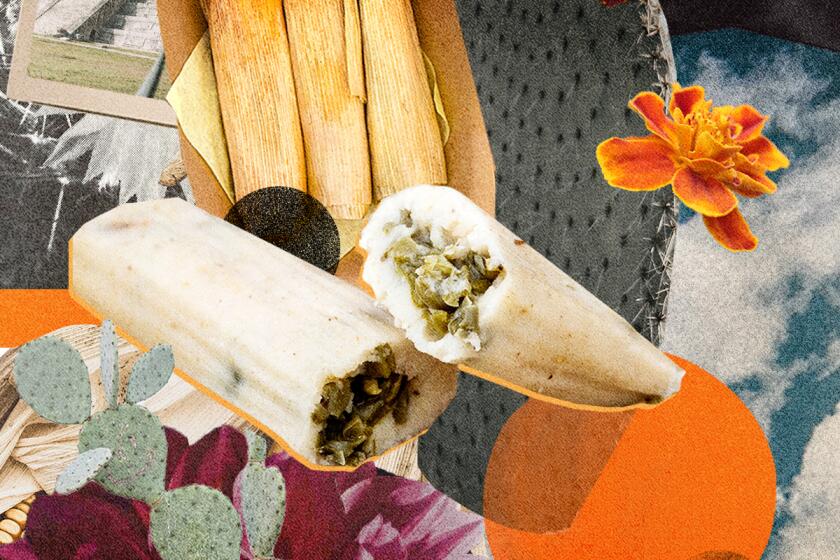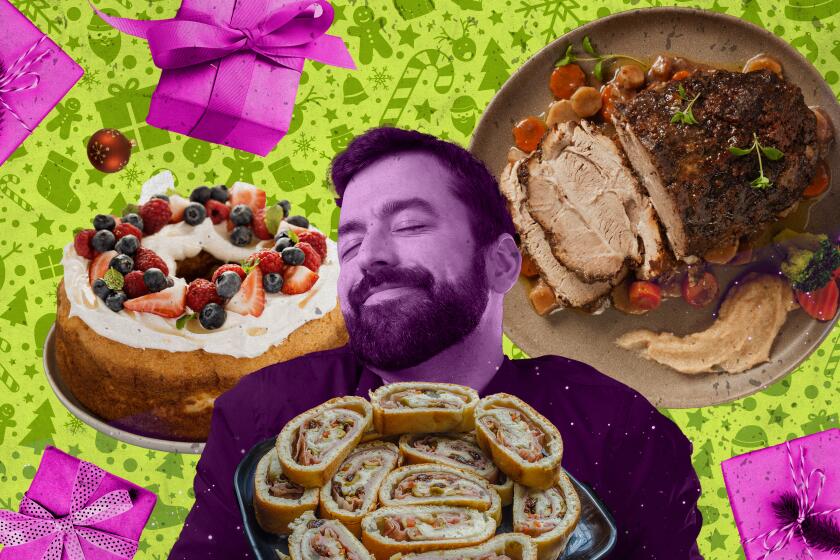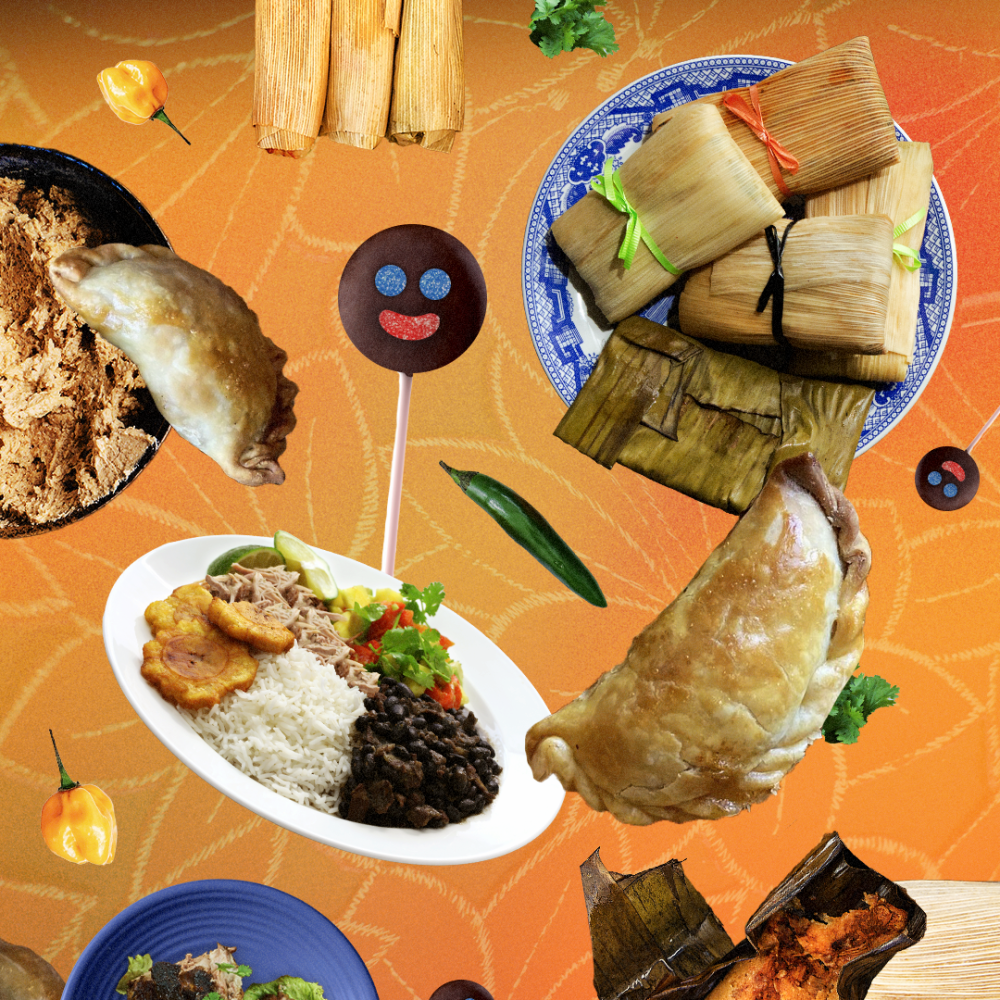
- Share via
The holidays are here, and although celebrations vary based on culture and region, growing up in Latino households means it’s time for food prep, cleaning (oh, the cleaning!) and pachanga.
Many will celebrate Christmas a day early, as they deem Nochebuena the Super Bowl of holidays. Others will join the tamal or empanada assembly line, creating dishes that represent more than cuisine but are tied to identity too.
As we celebrate the season, we asked staff to share the unique traditions that make their holidays special.
From Mexico to Argentina, each Latin American country brings its flair to Christmas and New Year’s Eve celebrations.
Gifting a Paleta Payaso
Andrea Flores, De Los reporter
Every year for Christmas my dad thinks it’s funny to gift us a Paleta Payaso, the chocolate-shelled marshmallow lollipop with a gummy smile and eyes. He doesn’t even try to trick us. He wraps it in the round shape that it’s in but we all go along with the bit and act clueless when we open it.
I’ve never asked him why he gifts us the clown paleta, but I think it’s to remind us to stay humble when opening gifts and to be appreciative of the little joys we might receive during the holiday season. My dad didn’t grow up receiving presents, so I also think he’s healing his younger self by gifting us something you give to children. Seeing his wide smile and eyes light up as we open the Paleta Payaso fills me with so much happiness.
Blending cultures with jerk chicken tamales
Chelsea Hylton, De Los reporter

My family has had a holiday tradition since I was a little girl: making tamales. Every year in December my mom buys masa and my sister and I are in charge of helping her. Aside from traditional Mexican tamales, we also make some that are a little bit different. Since my dad is Jamaican, we eat a wide variety of food in our household.
A few years ago my mom started adding jerk chicken (a traditional Jamaican dish) into her tamales. It was honestly the first time I felt both of my cultures combined perfectly into one dish. Although I may not be the biggest fan of them, they represent who I am. It may be tedious at times to spend hours making tamales but I also know it is an important tradition that my mom has carried for many years. She grew up seeing my grandma make holiday tamales and my great-grandmother as well. It’s a moment that I cherish with my mom and sister in the kitchen every year.
When my mom made these new tamales, I felt a greater appreciation for my multicultural household and it made me reflect on the obstacles that had to be overcome for it to exist.
Always help with the buñuelos
Steve Saldivar, L.A. Times video journalist
My mom doesn’t have many rules for the holidays but she does have one, even if it was just in jest: If you don’t help make the buñuelos, you can’t eat them.
Maybe it was one way to get me off the Super Nintendo as a kid. Or her way to help bring us closer for Christmas. Either way, it worked.
Every Christmas eve, cream-colored saucers resting on clean white linen spread over the bed, tables and even the sofa — they would take over the house. If we’d leave them out too long, they would crack from drying out. If not out long enough, they were too fresh. It’s a science.
As a child, I would be tasked with bringing those cold, stiff saucers to her as she dipped them in the pan. Now, I’m on cinnamon and sugar duties, fishing them out of the pan as soon as they turn golden brown and sprinkling them with sweetness.
Rules were made to be broken, just not this one: Always help with the buñuelos.
Making Argentinian empanadas
Martina Ibáñez-Baldor, De Los design director
The one thing that unites my family during the holidays is making empanadas. It’s truly a family affair. My Chilean father makes the masa while my Argentinian mother makes the fillings: carne, jamón y queso and choclo y queso. My siblings and I are in charge of filling the tapas and creating the repulgues, the crust’s unique crimps and sealings. Traditionally the different repulgue tells you what kind of stuffing the empanada has (braided edges are carne, edges closed with a fork are jamón y queso).
As kids we took the matter into our own hands. We played with the masa like Play-Doh, adding shapes to the top of the empanadas or poking our initials with a toothpick. We made special-request empanadas — no olives, extra olives, extra hard-boiled eggs — and came up with creative ways to identify them in the repulgue.
Sometimes making empanadas felt like a chore, but I’m grateful my parents kept the tradition alive to help us feel connected to our family and culture that often felt so far away. Plus, after a day of cooking, we were rewarded with bowls and bowls of empanadas that we ate for days — until we couldn’t eat anymore.
For modern-day chefs who are descendants of Latin American cuisine, room exists for traditional recipes to bend and crack, opening up possibilities for something new and reflective of today’s culture.
A million NYE rituals
Diana Ramirez, De Los art director
Ringing in the new year at a Mexican household is not for the weak. The holidays truly aren’t complete without some random tradition your tía and mom decided to follow (or made up) years ago. Do you know how many things must be done at midnight?
- Eat 12 grapes while making 12 wishes within the first minute of the hour.
- Hug everyone in the household and wish them a happy new year.
- Walk luggage out the door for more travel opportunities.
- Buy and wear red or yellow underwear for luck with love and money.
- Make sure you hit the ATM so you can have cash in your wallet for money abundance.
The list goes on and on.
Preserving abuelita’s Guate tamal recipe
Susana Sanchez, L.A. Times art director/designer
Guatemalan tamales are the best tamales in the world. I know these are fighting words, but when you grew up in a household of women who’ve been making tamales together since the ’60s, you can’t eat other versions.
Guate tamales are wrapped in banana leaves and they are double the size of most Mexican tamales. Since my father is Nicaraguan, my mom would also make nacatamales just for him. (Nacatamales are bigger than Guate tamales!)
Growing up I remember this well-oiled assembly line that was my mami, my two tías and my abuelita Rosa as the conductor/jefa. Making over 100 tamales was a 24-hour job my tías took seriously, while gossiping, dancing and laughing all day and night. Around midnight, our one-bedroom apartment in Hollywood was permeated with the most delicious aroma. I can still remember my New Kids on the Block posters on my bedroom wall getting ruined because the entire apartment became a sauna from the nonstop cooking. The reward was delicious homemade tamales for breakfast, lunch and dinner or until we ran out.
After my career took me to various states, I tried to keep this tradition going by hosting tamal parties with co-workers or family. I’ve flown in my mami and abuelita to teach my Asian American husband what ingredients to buy, teach my co-workers how to clean banana leaves and share the key to a mouth-watering Guate-style tamal: lots of sauce.
When COVID hit, my kids were devastated to learn it would be our first year without tamales and family. Their sadness became my ignition to try to make tamales alone. My mom texted me the ingredients and walked me through the process over eight hours of on-and-off FaceTime calls. My husband and kids were the assembly line and I was the conductor/jefa like my abuelita Rosa. I made 40 tamales, and although they were a little dry, my sauce was the bomb.
¡Si pues! I did it.
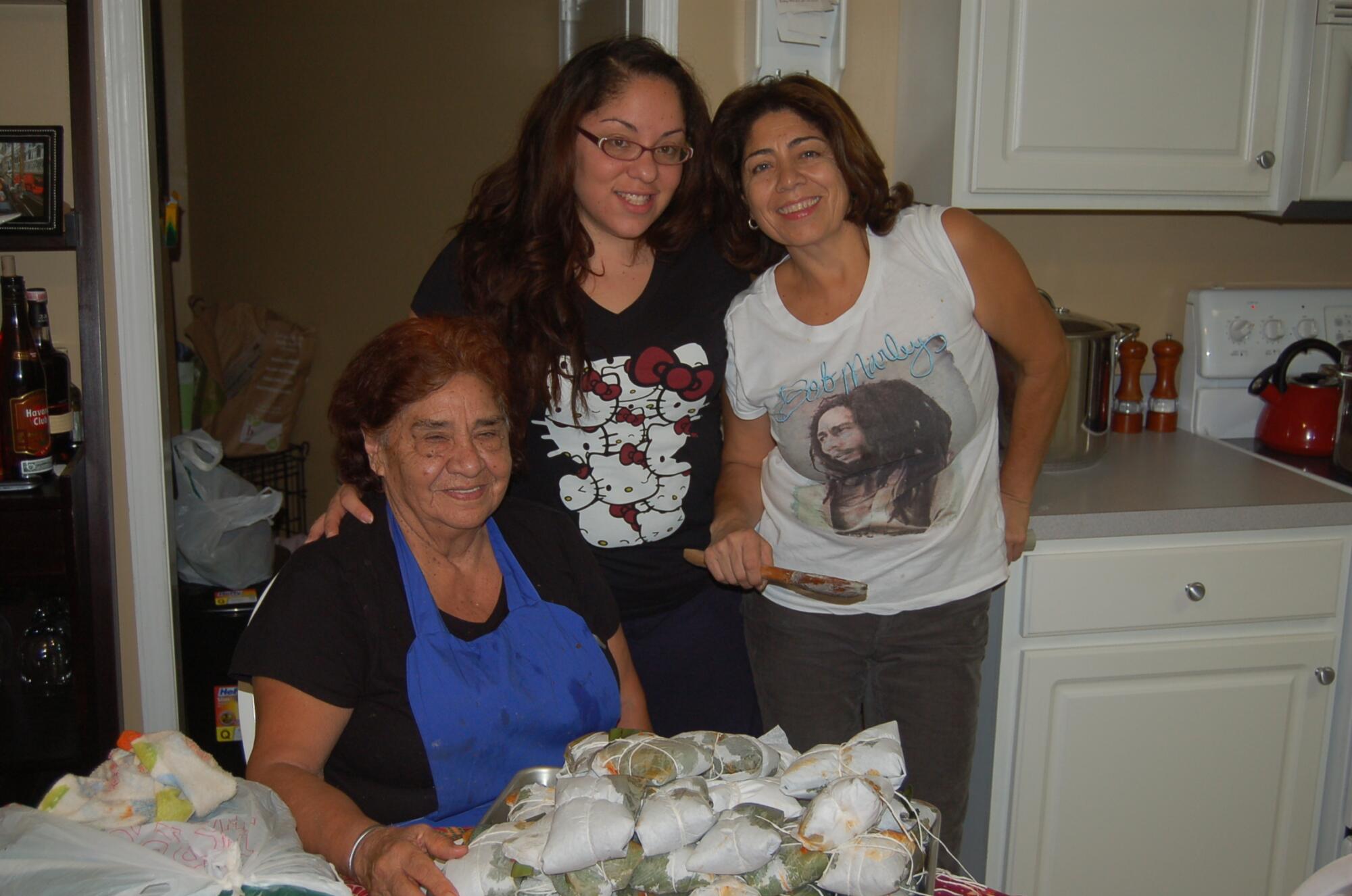
Warm up with a drink with Mayan origins, sing along to a gaita from Venezuela, and delight with a flancocho from the Dominican Republic.
Farm-to-table lechón asado
Angel Rodriguez, De Los general manager
My Christmas traditions revolved around the acquisition, preparation and consumption of the lechón. Growing up in a Cuban American family in Texas meant that the planning of the Nochebuena celebration started weeks in advance. My dad and my brother-in-law were the ones who took care of finding a farm that provided a pig big enough to feed 20 to 25 people with plenty of leftovers.
For most of my life, my involvement was limited to showing up to eat once the pig was prepared for dinner. But as I got older I became a bit more involved in the process, and it wasn’t always by choice. One year my dad asked me to accompany him to get the pig. I hadn’t really given too much thought to the process of getting the pig, and the concept of “farm to table” wasn’t in my vocabulary. But on the drive to the outskirts of Houston, where the strip malls gave way to farmland, it started to hit me that this wasn’t really going to the grocery and picking out a piece of meat from the butcher. I’ll spare you the details of what happened next at the pig farm.
The best times involved when the large pig was ready to be carved and everyone would gather around and pick at the lechón before it was served. My dad knew who liked what and how they liked it. So whenever a toasty piece of skin was carved out, we knew it was going to my cousin. Everyone had their favorite bites.
As time went on and I and others in my generation moved away from home and age kept the older generation from putting in all the work to prepare these large meals, the celebrations became much more muted. There is still lechón, rice, black beans and yucca but the portions are much more manageable.
As a Cuban kid growing up around people from all over the world, Nochebuena and the traditions around it made me feel like I belonged to a country and a culture that I had always felt isolated from.
California Nochebuena on Central Standard Time
Angie Orellana Hernandez, L.A. Times reporting fellow
In 2006, my family and I had our first Christmas away from Guatemala. It was a sharp shift felt by my parents, who said our village in Escuintla would throw big street festivals and have community potlucks for the holidays.
But it had been less than three months since we immigrated to California, so we didn’t know what to do, who to visit or where we could find a semblance of the life we used to know. My mom, ever the problem solver, thought of a solution: Let’s try to bring a piece of home to Sacramento.
So now on Nochebuena, the house runs on Central Standard Time, Guatemala’s time zone.
But before we can open presents at 10 p.m., my mom mobilizes the family for mandatory tamal duty. My sister and I clean the hojas de platano, my dad and brother stir the masa in a giant silver pot until it thickens, and then my mom and abuelita assemble the pieces together. No one is allowed to slack off.
My family has tried to adopt more American traditions — dressing up in plaid pajamas, visiting Santa at the local mall, building a gingerbread house — but, at least for us, there’s nothing better than dinner at 8, gifts at 10, bed by midnight and the entire next day to sleep in.
More to Read
The Latinx experience chronicled
Get the Latinx Files newsletter for stories that capture the multitudes within our communities.
You may occasionally receive promotional content from the Los Angeles Times.
